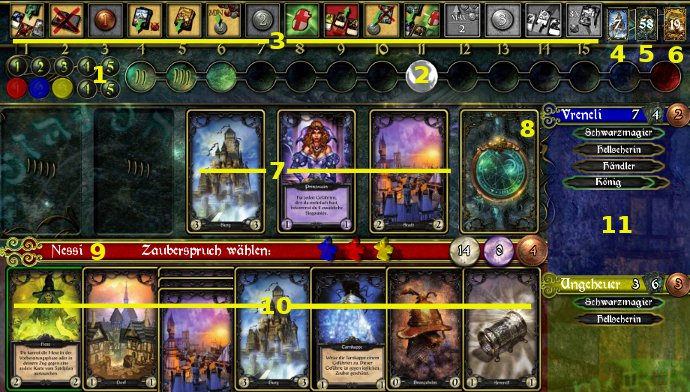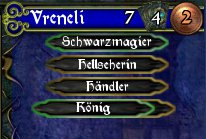Grimoria
Game information
Grimoria is a magical game that offers easy entry, but has quite tactical potential for advanced players.
2 - 5 magicians fight for the throne in Grimoria. With the help of their spells and helpful companions, they try to collect as many magic points as possible in order to gain the power over Grimoria in the end.
This rule mainly provides the operation for the online game. In addition, the original instructions may be used.
Field

- Player order
- Round indicator
- Magic spells
- Stacks (open)
- Redrawing stack (covered)
- Treasure Card Stack
- Open adventure cards
- Hidden adventure map
- Status display
- Own adventure maps (the new cards that have been added since the last round are shown in green outline)
- Mitspieleranzeige (Detail view via Mouseover). Here, too, the new cards are bordered green.

The player name is on the left. In the middle, you will see what action the player has to do right now. The current win points are displayed on the right. The left number stands for the current number of points by configured cards (without extra points by purple companions). The average number shows the (own, current) victory points by purple companions and the number on the right stands for their own thaler stock.

In the overview of the opponents' gamblers you can see companions listed. The new cards will be displayed in a green border.
The numbers on the right of the name are available for current scores with maps (without extra points by purple companions), number of hidden cards and thaler stock.
Before the start of the game
In the game are 87 adventure cards and 28 treasure cards. Both lie next to the schedule as a hidden stack. A card is open from the adventure cards at the beginning of each round per player. In addition, a hidden card comes, so that a card is more out of place than players take part.
Depending on the number of players, the round indicator is set to the corresponding field (4/5/6).
Each player receives a Taler start capital.
Game sequence
Grimoria runs in several rounds, each of which consists of three phases:
- Spellbook phase
- Adventure phase
- Preparatory phase
Spellbook phase
All players choose (covered) one of the spells (3) by clicking on the corresponding field. Only the spells up to and including the white marker (2) can be selected; i.e. in the course of the game, the selection continues to expand, while at the beginning only a few spells are available.
An explanation of the individual spells is given by Mouseover. More detailed the spells on their own page explained.
After all players have chosen a spell, the new player order is determined. The first thing to do is look at which players stand alone on a spell. From these is the first one who is the farthest left, that has chosen the weakest spell; the other ("seaters") follow accordingly. After that, the rest of the players who did not sit alone on a spell will be looked after. The weakest spell is now also evaluated first. The players involved now come behind the "seaters", where the order of the last round is decisive.
Example:
Current order

In the spell book phase, the following five spells were selected:

As black is the only one sitting alone, he's coming to the first. From the "double seats" blue and green have the weakest spell, so first are taken into account. Since green sat before blue in the last round (see above), green now comes to 2 and blue to 3. Then follow yellow and red, setting yellow to 4 and red to 5, as yellow in the round also sat before red.
Adventure phase
After the new order now, each player, starting at 1st place, will finish his magic spell (most of them will be done automatically). After that he may draw one of the designed adventure cards. He can either take one of the open or the hidden right. The cards are not refilled immediately. So who comes last has little choice!
There are two types of adventure cards: buildings (huts, village, town, castle) and companions. The first ones are just winning points. The Companions have certain properties that either bring advantages in the game (brown text field) or at playing extra points for certain conditions (lila text field).
An explanation of the individual adventure maps is given by Mouseover. More detailed they will be on their own page explained.
Preparatory phase
If each player has chosen a card, the remaining card moves to the storage stack. New cards are redesigned as at the beginning and the round indicator moves one position further to the right.
Playing
As soon as the round indicator reaches the red field to the right, the last round begins. This is still played normally, then the game ends. Now the points are calculated:
- Each valley brings 1 victory point
- Buildings and treasure maps (by magic spell 5) bring the printed victory point number
- Companions bring the printed victory point number
- Companions with purple text field still bring extra win points when the conditions are fulfilled
The player with most win points wins. At the same time, the number of valleys counts. If there is equal status here, there are several winners.
To the Almanach of the spells, companions and treasure maps.
Game-specific prop commands
For Grimoria some game-specific prop commands are available:
If you do not need the flashing cards after some games, you can use the plot
Grimoria.CardPopup = off
turn off. With "on" it is switched on again.
If the color distribution does not like it, it can change as follows:
Grimoria.PlayerColor1 = 0000FF
For the corresponding player position, the desired color must then be specified in the hex code. Here in the example, player 1 would have blue instead of red.

